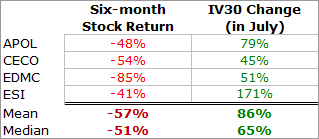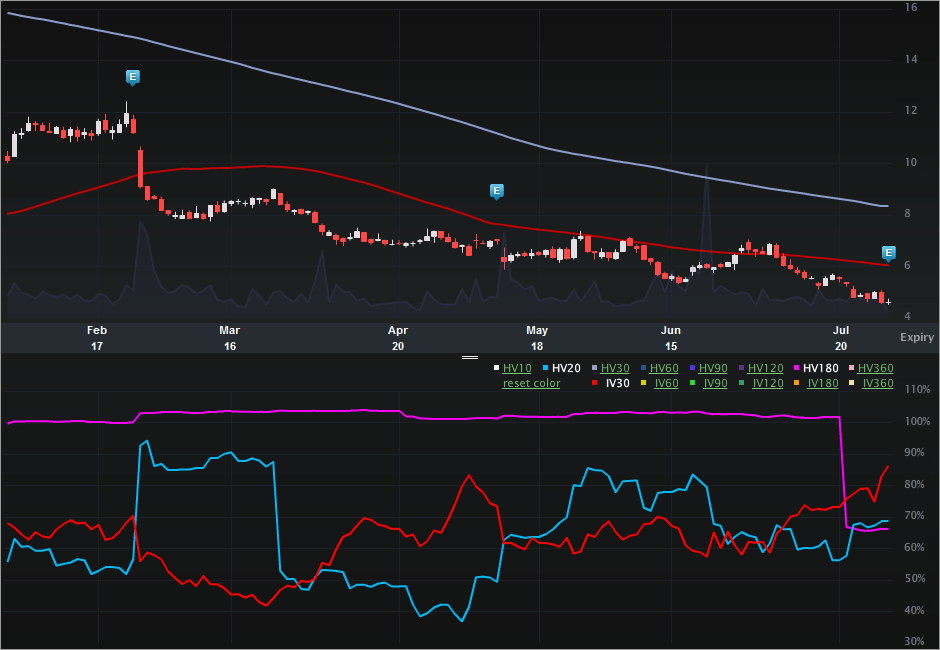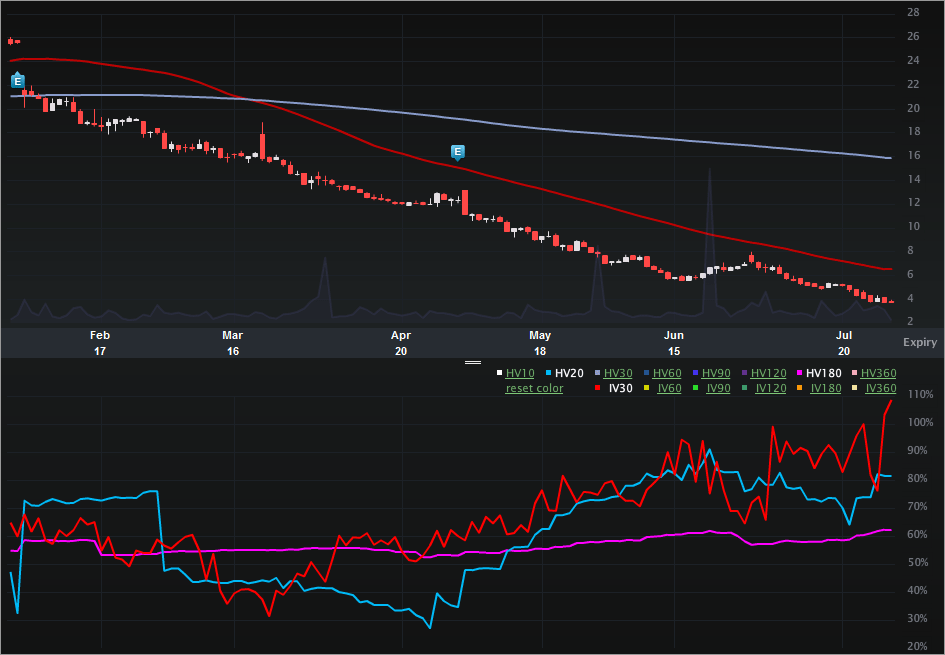This is an industry wide note on for-profit education after a scathing review and analysis from the US Senate was made public. Let's start with the news, and move through the review in bits and pieces, then, we'll look at the vol and stock. But, as a motivator to get through all the text below, check out some stock and vol stats:
So, we're talking about a group that is down more than 50% in the last six months, with vols spiking even more than that. I raise this question at the conclusion of the analysis, but I might as well put it up front as well:
"If the federal government pulls funding for student loans at these institutions, could they all just go away overnight?"
The source for all of the following Senate report "stuff" is a great Bloomberg article written by John Hechinger and Oliver Staley, published on Jul 30, 2012 1:32 PM PT.
To set the stage, here's the overview:
For-profit college chains including Apollo Group Inc. (APOL) pressured students to enroll while dodging questions about costs, according to a Senate report that cites a trove of internal e-mails and training documents.
The schools received $32 billion in tuition aid in 2009-2010 and aren’t a good investment for taxpayer money, according to the study released yesterday. In its probe, the Senate Committee on Health, Education, Labor and Pensions, led by Iowa Democrat Tom Harkin, examined 30 companies over two years.
“In the absence of significant reforms,” the report said, “the sector will continue to turn out hundreds of thousands of students with debt but no degree, and taxpayers will see little return on their investment.”
To be fair, there was a counter argument put forth in a minority report in yet another example of how divisive our own political system has become:
In a minority report, Senate Republican staff members criticized the report’s findings, saying that Democrats repeatedly refused to work in a bipartisan manner and expand the scope of the investigation to include nonprofit and state universities, raising “substantial doubt about the accuracy of the information.”
The majority report, on the other hand, openly accused the for-profit education companies:
“In this report, you will find overwhelming documentation of exorbitant tuition, aggressive student recruiting and abysmal student outcomes,” Harkin [] said. “These practices are not the exception. They are the norm.”
Apollo recruiters are trained not to provide direct answers about costs when speaking with recruiters, according to materials cited in the majority report.
“If a prospect says, ‘You’re too expensive,’ the recruiter could respond, ‘Can you afford not to go?’” or “If you are going to making more money, wouldn’t these loans be easier to pay back?,” according to a 2007 training manual cited in the report.
The manual urges recruiters to “create urgency in your students” so they don’t wait to sign up. It counsels recruiters: “Do not tell the student we have classes running every week unless you can agree on a start date, or rolling start dates is a selling point.”
Here are some incredible statistics:
The report, more than 1,000 pages long, takes aim at Apollo’s University of Phoenix, Education Management Corp. (EDMC), Washington Post Co. (WPO)’s Kaplan Higher Education and other for- profit colleges, which as a group spend more on marketing than instruction.
[For-profit colleges] rely on federal financial-aid money for as much as 90 percent of their revenue.
The schools also devote more staff to recruiting new students than ensuring the success of their existing ones, according to the study. [...] As a result, 596,556 students who enrolled in the 2008-2009 school year dropped out by mid-2010, the report said. In two- year associate’s degree programs, 64 percent dropped out.
For-profit college students take on more debt, with 96 percent receiving loans compared with 48 percent at four-year public schools. They also default at a higher rate than their counterparts at nonprofit institutions. Almost half of federal student loan defaults came from students at for-profit schools.
Consider some of those stats -- if 90% of the industry's revenue comes from the government, and the government just concluded that these firms, and I quote, "aren’t a good investment for taxpayer money," well, to use a technical term, the may be screwed.
With data that shows, "[a]lmost half of federal student loan defaults came from students at for-profit schools," maybe the Senate is right?
But the colleges are not taking the attacks lightly and have pushed back stringently on the conclusions of the analysis. Here is some of that:
Steve Gunderson, president of the Association of Private Sector Colleges and Universities, which represents for-profit schools, said his members provide education to 3.8 million students, including working adults and veterans.
“The report twists the facts to fit a narrative, proving that this is nothing more than continued political attacks on private sector colleges and universities,” Gunderson in a statement.
The report noted, as an example of “significant reforms,” a Kaplan program that lets students try out classes before committing to take out loans.
“The bulk of the report repeats prior criticisms and relies on dated, isolated situations to characterize current practices,” Kaplan said today in an e-mail.
In a letter to Harkin, ITT said the complaints in the report “are not representative of typical student experiences.”
The training manual is outdated and doesn’t reflect Apollo’s approach to enrolling students, Rick Castellano, a spokesman, said in an e-mail.
Apollo Group in 2009 began offering a mandatory orientation program that lets students try programs before committing to taking on debt. The U.S. Education Department and the Harkin report both praised that program, Castellano said.
The Bloomberg article shines some light on actual recruiting processes:
At Education Management, which runs a chain of Art Institutes and other programs, the company pushed recruiters to meet enrollment targets, according to e-mails. “Please everyone hit the phones!!!,” a manager wrote in a 2008 e-mail. “We are far behind where we need to be!!!”
Supervisors offered prizes such as company-paid trips, including to Hawaii, according to the report. EDMC told investigators that it never sponsored such a trip.
Jacquelyn P. Muller, an Education Management spokeswoman, said the company hasn’t had the chance to review the full report.
OK, so there's all that stuff 'n stuff. Let's turn to the stock and vol charts (six months) for four of these companies. The top portion is the stock price, the bottom is the vol (IV30™ - red vs HV20™ - blue vs HV180™ - pink).
APOL 
CECO
EDMC
ESI
Ultimately, we can see very poor stock performance over the last six months as well as an abrupt rise in IV30™ over the last month (recall the stats at the top of the article). I do note that CECO has earnings due out today, AMC.
I haven't included the skews, but suffice it to say, while they have all maintained a fairly "normal " shape, the front expiries are elevated to the back in a monotonic relationship. In English, the option market reflects the fact that the near-term risk is elevated relative to the medium-term. The question I ask is, "can these companies lose a substantial piece of their federal aid (for loans), and if so, do they just go away?"
Disclaimer: This is trade analysis, not a recommendation.
- English (UK)
- English (India)
- English (Canada)
- English (Australia)
- English (South Africa)
- English (Philippines)
- English (Nigeria)
- Deutsch
- Español (España)
- Español (México)
- Français
- Italiano
- Nederlands
- Português (Portugal)
- Polski
- Português (Brasil)
- Русский
- Türkçe
- العربية
- Ελληνικά
- Svenska
- Suomi
- עברית
- 日本語
- 한국어
- 简体中文
- 繁體中文
- Bahasa Indonesia
- Bahasa Melayu
- ไทย
- Tiếng Việt
- हिंदी
For-Profit Education: Is An Entire Industry Going Away?
Published 08/01/2012, 05:44 AM
Updated 07/09/2023, 06:31 AM
For-Profit Education: Is An Entire Industry Going Away?
Latest comments
Install Our App
Risk Disclosure: Trading in financial instruments and/or cryptocurrencies involves high risks including the risk of losing some, or all, of your investment amount, and may not be suitable for all investors. Prices of cryptocurrencies are extremely volatile and may be affected by external factors such as financial, regulatory or political events. Trading on margin increases the financial risks.
Before deciding to trade in financial instrument or cryptocurrencies you should be fully informed of the risks and costs associated with trading the financial markets, carefully consider your investment objectives, level of experience, and risk appetite, and seek professional advice where needed.
Fusion Media would like to remind you that the data contained in this website is not necessarily real-time nor accurate. The data and prices on the website are not necessarily provided by any market or exchange, but may be provided by market makers, and so prices may not be accurate and may differ from the actual price at any given market, meaning prices are indicative and not appropriate for trading purposes. Fusion Media and any provider of the data contained in this website will not accept liability for any loss or damage as a result of your trading, or your reliance on the information contained within this website.
It is prohibited to use, store, reproduce, display, modify, transmit or distribute the data contained in this website without the explicit prior written permission of Fusion Media and/or the data provider. All intellectual property rights are reserved by the providers and/or the exchange providing the data contained in this website.
Fusion Media may be compensated by the advertisers that appear on the website, based on your interaction with the advertisements or advertisers.
Before deciding to trade in financial instrument or cryptocurrencies you should be fully informed of the risks and costs associated with trading the financial markets, carefully consider your investment objectives, level of experience, and risk appetite, and seek professional advice where needed.
Fusion Media would like to remind you that the data contained in this website is not necessarily real-time nor accurate. The data and prices on the website are not necessarily provided by any market or exchange, but may be provided by market makers, and so prices may not be accurate and may differ from the actual price at any given market, meaning prices are indicative and not appropriate for trading purposes. Fusion Media and any provider of the data contained in this website will not accept liability for any loss or damage as a result of your trading, or your reliance on the information contained within this website.
It is prohibited to use, store, reproduce, display, modify, transmit or distribute the data contained in this website without the explicit prior written permission of Fusion Media and/or the data provider. All intellectual property rights are reserved by the providers and/or the exchange providing the data contained in this website.
Fusion Media may be compensated by the advertisers that appear on the website, based on your interaction with the advertisements or advertisers.
© 2007-2024 - Fusion Media Limited. All Rights Reserved.
